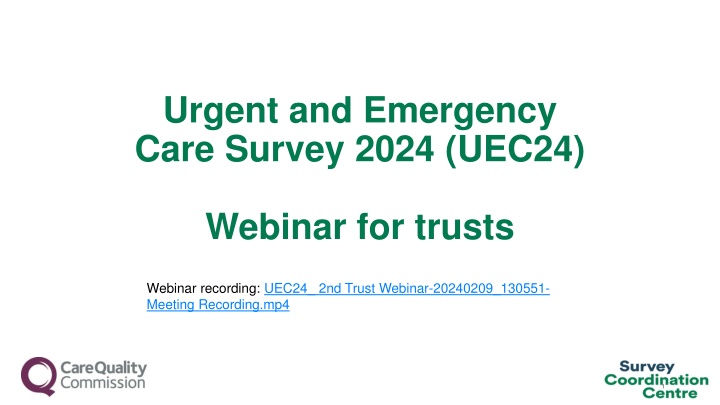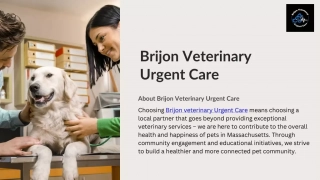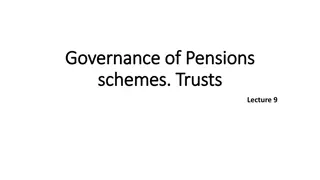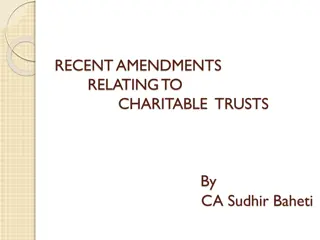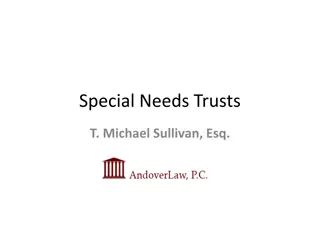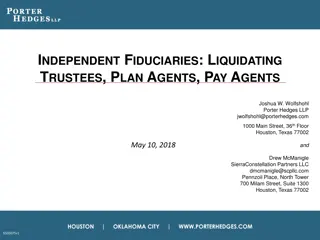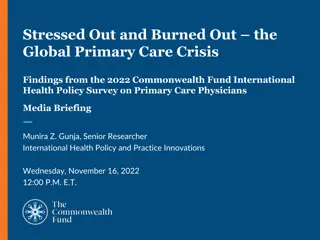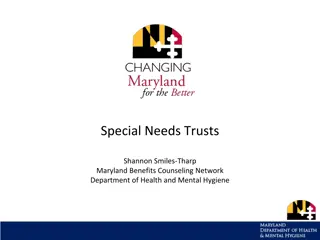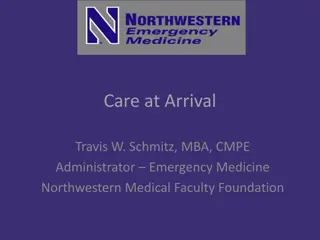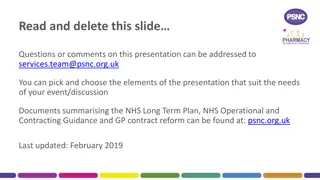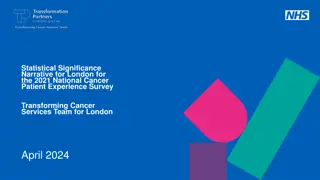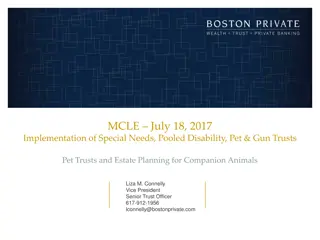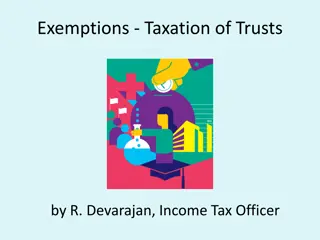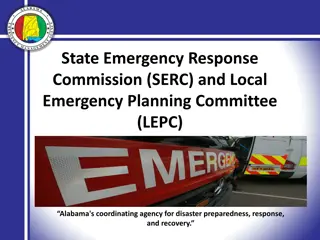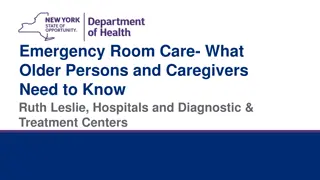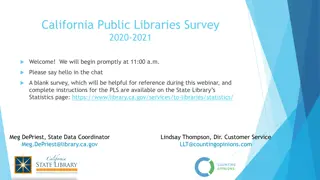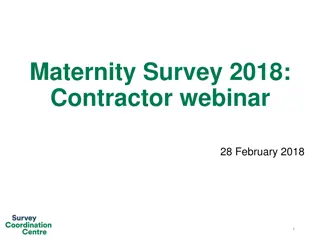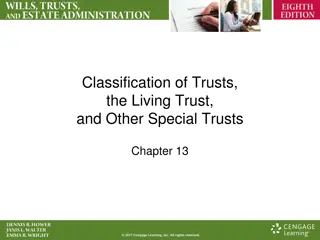Urgent and Emergency Care Survey 2024 Webinar for Trusts
This webinar provides an overview of the 2024 UEC survey, including changes in sampling, questionnaire development, and data protection requirements. It highlights the shift to a mixed-mode approach, encouraging online completion with a paper option. Sampling criteria and new variables are detailed for trust submissions. Key dates, instructions, and potential errors are discussed for efficient fieldwork implementation.
Download Presentation

Please find below an Image/Link to download the presentation.
The content on the website is provided AS IS for your information and personal use only. It may not be sold, licensed, or shared on other websites without obtaining consent from the author.If you encounter any issues during the download, it is possible that the publisher has removed the file from their server.
You are allowed to download the files provided on this website for personal or commercial use, subject to the condition that they are used lawfully. All files are the property of their respective owners.
The content on the website is provided AS IS for your information and personal use only. It may not be sold, licensed, or shared on other websites without obtaining consent from the author.
E N D
Presentation Transcript
Urgent and Emergency Care Survey 2024 (UEC24) Webinar for trusts Webinar recording: UEC24_ 2nd Trust Webinar-20240209_130551- Meeting Recording.mp4 1
Agenda Overview of 2024 survey [5 mins] Sampling and contact approach [15 mins] Questionnaire development [15 mins] Data Protection and Section 251 Requirements [5 mins] Potential Sampling Errors [5 mins] DBS checks [5 mins] Instruction Manuals [10 mins] Entering fieldwork [5 mins] Key dates [5 mins] Questions [10 mins] 2
Overview of the 2024 survey 3
Introduction Mixed mode approach Shift to a mixed-mode approach offering online and paper questionnaire options. Push to web We are encouraging patients to complete the survey online, with a paper questionnaire as an option if the patient prefers Contact approach Adoption of a six-contact attempt strategy, combining postal mailings and SMS text messages. Sampling There are changes and additions to the sampling variables as well as a change to the sampling period Questionnaire The questionnaire has undergone significant changes following consultations with stakeholders. Due to these changes comparisons between UEC24 results and previous iterations of the survey will not be possible. 4
Sampling and contact approach 5
Sampling criteria Stratified random sample of patients aged 16+ Trusts submitting Type 1 only sample: Draw 1250 patients who attended in February 2024 only. Trusts submitting Type 1 and Type 3 samples: Draw 950 Type 1 patients who attended in February 2024 and 580 Type 3 patients who attended in February 2024. Type 3 are permitted to sample back to January 2024 if they are not able to meet the required sample size in February alone. Please note: You may only submit a Type 3 sample if your Type 3 departments are directly run by your trust. Type 3 departments that are run by another provider must be excluded. Trusts submit a combined sample and mailing file to contractors. Full details will be in the Sampling Instructions. 6
New sampling variables Mobile Phone Numbers: Due to the survey moving to mixed mode, trusts are requested to provide patients' mobile phone numbers for SMS reminders. This should be the current mobile phone number listed on your system, either an 11-digit number starting with 07 or a 12-digit number starting with +44 7 . They are needed for sending unique login details for the online survey. Crucial that mobile numbers are included where possible - Pilot results found participants were more likely to respond when a mobile number was available in the sample. Mobile numbers should only be shared with approved contractors and not with the Survey Coordination Centre (SCC) to comply with Section 251. 7
Further Guidance on Mobile Numbers Access to Mobile phone numbers: Section 251 approval grants the legal basis to allow access to the specified confidential patient information without consent. This approval includes mobile numbers too. Exception: if the patient has explicitly dissented to the use of their mobile number, or if there is a note specifying that the number belongs to someone other than the patient, such as a carer or family member. However, if the patient has provided a work mobile for their records this is fine to include, If there are no notes alongside the number it s fine to assume this belongs to the patient. If patients have different numbers listed in the mobile and telephone fields: Please prioritise the mobile column. If you have any records where the mobile field is blank, and the telephone number field is populated with a mobile number, please include this.
New sampling variables (continued) NHS Number Introduced as a new variable to facilitate centralised DBS checks for trusts. The NHS number will be part of the mailing data and shared with approved contractors for DBS checks. SCC also will use NHS numbers for linkage to the Emergency Care Data Set (ECDS) for further analysis. Full Date of Birth: Trusts are requested to provide the full date of birth to enable contractors to conduct centralised DBS checks. Full date of birth will only be shared with approved contractors for DBS checks; the SCC will receive only the year of birth. 9
New sampling variables (continued) Further guidance on these variables is available in the ECDS Technical Output Specification (ETOS) V4.0.7 Emergency Care Chief Complaint (SNOMED CT): Identifies the main reason a patient is seeking emergency care. Helps understand the patient's chief complaint, recorded by the first healthcare provider. Diagnosis (SNOMED CT) Documents the patient's diagnosis as determined by a health professional. Enables analysis of patient experience by medical condition. Trusts should use the 1st Confirmed diagnosis according to the CODED CLINICAL ENTRY SEQUENCE NUMBER if available or if there are no Confirmed Diagnosis then the first in sequence.' Emergency Care Acuity (SNOMED CT) Indicates urgency and severity of the condition, defined by the first clinician who assesses the patient. SNOMED code should be inserted into the sample Person Score: Indicates urgency and severity of the condition, calculated from the Royal College of Physicians NEWS2 assessment tool. Tracks changes in a person's health over time. o Please include Person score recorded on first assessment using NEWS2 score. Designated UTC: New variable to indicate whether the Type 3 service has been designated as a UTC or not designated (UCC/MIU). Helps understand the emergency care department type for future surveys. 10
Data collection approach Contact approach: Paper letter and SMS contacts (example dates) Mailing 2 is five working days after mailing 1 Mailing 3 is ten working days after mailing 2 SMS texts are 3 working days after each mailing All postal mailings include multilanguage sheet Example mailing dates Week 1: Monday 15/04/2024 Week 1: Thursday 18/04/2024 Week 2: Monday 22/04/2024 Week 2: Thursday 25/04/2024 Week 4: Tuesday 7/05/2024 (Monday 6th May is a bank holiday, so goes next working day) Week 4: Friday 10/05/2024 Contact type Mailing 1/Contact 1: Letter with URL / QR code Contact 1.1: SMS despatched Mailing 2/Contact 2: Letter with URL / QR code Contact 2.1: SMS despatched Mailing 3/Contact 3: Letter (No URL or QR code) and mail questionnaire Contact 3.1: SMS despatched 11
Cover letter changes Changes to covering letters both Type 1 and Type 3: Wholesale changes to cover letter text o Change to mixed mode has led to the inclusion of: o Instructions on how to access online survey o Survey number o Online password o Survey link o QR code Wholesale changes to privacy and data security text Only 3rd cover letter will include paper questionnaire along side a freepost envelope Each mailing pack will include the multi-language sheet o o o 12
SMS text reminder examples SMS text reminders aim to encourage higher online survey participation SMS 1 (invitation) From: NHS Survey SMS 2 (nudge) From: NHS Survey SMS 3 (final reminder) From: NHS Survey We recently sent you a letter about your experience of A&E at [SITE NAME]. Please click on the link to give feedback: [unique link]. You don t need to enter your log-in details. Any questions or wish to opt out? Please call Freephone [CONTRACTOR OR IN- HOUSE PHONE NUMBER]. [SITE NAME] would welcome your feedback. Please tell us about your recent experience at A&E by completing the survey: [unique link]. Any questions or wish to opt out? Please call Freephone [CONTRACTOR OR IN-HOUSE PHONE NUMBER]. Please help the NHS by telling us about your recent A&E experience at [SITE NAME]. Please complete the survey by 26th July 2024: [unique link]. Any questions or wish to opt out? Please call Freephone [CONTRACTOR OR IN-HOUSE PHONE NUMBER]. Optional additional text: Optional additional text: Wording Your ID number is XXXXXXX. Optional additional text: Your ID number is XXXXXXX. Your ID number is XXXXXXX. 3 days after mailing 1 3 days after mailing 2 3 days after mailing 3 Date 4-5pm 2-3pm 9-10am Time 14
Other survey materials Dissent Posters Posters should be displayed during the sampling period (January and February 2024) to ensure Section 251 compliance Dissent posters inform potential participants and provide them with an opportunity to opt- out of the survey in advance Posters should be prominently displayed where trusts deliver services (can also be posted on social media). Posters are available in English and 21 other languages 15
Other survey materials Publicity activities Press Release template Press Release template outlining the purpose and value of the UEC24 survey for trusts. Trusts can add text on how they have used the survey results to achieve improvement. Already been shared with trusts for pre-fieldwork publication Social media cards Social media cards, one call to action and three reminders, to be shared with trusts and national organisations. Promotes survey on platforms like Facebook, Twitter, and LinkedIn. Enhances external awareness and engagement. These are currently being been tested with patients in cognitive interviews. Website banners Accompanies social media cards. Short, condensed survey messaging for website and social media channels. Social media cards and website banners to be shared with trusts pre- fieldwork (early April 2024) 16
Accessibility options Online survey: Ability to change font size On request: Telephone assisted complete helpline (including Language Line offered in 22 languages) Ability to change background colour Large-print questionnaires Screen reader compatible Easy Read Language options Braille British Sign Language 17
Questionnaire development process A thorough review of the questionnaires for Type 1 and Type 3 have taken place enabled by move to mixed mode and break in trend data. Stakeholder engagement & consultations Involvement at multiple stages during development. In-depth interviews and focus group discussions have been held with stakeholders (CQC, NHSE, DHSC, trusts and charities) and patients. Advisory Group Questionnaire priorities discussed and agreed 1st Trust webinar Feedback from first trust webinar incorporated Cognitive testing 3 rounds of testing questionnaire with recent UEC patients (currently in final round) Full details will be available in the Survey Development Report 19
Question Changes Since UEC22: Type 1 & 3 Wholesale changes are being made to both Type 1 and Type 3 questionnaires. Many edits and changes have been made since UEC22; these include: Additions: Ambulance handover experience (Type 1 only) Experience of service contacted prior to A&E/UTC (Online survey only) Patient reattendance reason Communication needs question Medications Information received at discharge Recontact question Amendments: Adjustments to the introductory text. Removals: A number UEC22 questions have been removed. 20
New Questions Arrival (Patient pathway into ED) Helpfulness of services contacted before patient arrives at ED: Question added to assess the perceived helpfulness of the selected service(s) the patients contacted before arriving at A&E or the UTC. (i.e. NHS 111, GP practice etc) Added to online only as question functionality does not work on paper questionnaire Ambulance questions: Determine whether the patient arrived at A&E via ambulance. Questions exploring the time spent waiting with the ambulance crew upon A&E arrival and whether the patient was informed about the wait. Reasons for A&E Reattendance: Question seeks to understand the reasons for patients returning to A&E for the same condition. 21
New Questions Waiting Post triage information: Question evaluating whether staff informed patients about the next steps in their care after the initial assessment. Your Care and Treatment Communication needs Question to identify whether patient had any communication needs, including language requirements related to disabilities or sensory impairments. Assistance with medication Question investigating whether staff helped patients with taking medication for pre-existing medical conditions. Medication Medication information Question on what information patients were given following prescription of new medication 22
New Questions Information Information provided at discharge Question assessing whether patients received information on caring for their condition at home before leaving A&E or UTC (ie verbal, written, or online information). Patient understanding of information received Question evaluating the extent to which patients understood the information about their condition or treatment provided before they left A&E or the UTC. Patient confidence in self-care Question gauging the patient's confidence in managing their condition at home based on the information they received. Recontact question Question asking patients if they are willing to allow their survey responses to be linked to contact details for possible future research by the Care Quality Commission. 23
Data protection and Section 251 requirements 24
General Data Protection Regulation (GDPR) How patient s personal data is being protected under the GDPR is stated on the reverse side of the covering letter for mailing 1 and 3: 25
Section 251 requirements The survey is approved under Section 251 of the NHS Act 2006. Section 251 allows patient data to be shared outside of NHS trusts without gaining prior and explicit consent from these patients. This includes the provision of mobile phone data. We ask you publicise the survey both internally and externally to ensure patients are aware of the survey and have the opportunity to opt-out should they wish. Example materials are available in the 'Publicising survey document. You can also use the publicity materials we will provide you with. Ensure a log of patients who have dissented from taking part in the survey is accurately kept. Report any Section 251 breaches immediately to your contractor or SCC. CQC will inform the Confidentiality Advisory Group of any breaches and review outcomes. 26
National Data Opt-Out Programme Exemption from National Data Opt-out Programme Surveys under NPSP, including UEC24, are not subject to the National Data Opt-out Programme. Patients cannot be excluded from the survey based on National Data Opt-out. Separate Opt-out Mechanisms: The UEC24 survey will maintain its own opt-out mechanisms (as outlined in the Sampling Instructions). Patients do not have to actively consent to the sharing of their data for the Urgent and Emergency Care Survey 2024.
Potential Errors - How to avoid them Examples of checks you should do before submitting your sample: Check distribution of patient ages and gender in your sample Also ensure no one born later than 2008 is in the sample Are there any errors in the query used to extract the eligible population? Are there any missing / incomplete data in your initial database? Be aware of system migrations. Ensure patients on the national opt out register are not excluded Check all codes provided in your sample are valid Ensure all times are in correct HH:MM format Check there are no duplicate Patient Record Numbers Ensure addresses are complete and no non-UK addresses. Check mobile numbers have 11 digits and ensure there are no landline numbers 29
Sample Declaration Form Completing the Sample Declaration Form can help avoid errors. Avoiding errors will ensure your questionnaires can be mailed out earlier and your data will be usable in this year s survey. Includes: o o Checklist Declaration Agreement To be signed by person drawing sample and Caldicott Guardian Tip: Take care to fill in dates Tip: Schedule time for sign-off in advance with Caldicott Guardian Submission Sample declaration form to be submitted to your contractor (or SCC if an inhouse trust) Once the sample declaration form has been approved, please submit your sample safely via secure file transfer site. 30
DBS Checks 31
DBS Checks DBS & local checks requirements Before mailing 1 Local checks AND DBS checks at the time of drawing your sample (further deceased checks may be needed if it has been 2 weeks or more since DBS checks prior to sample submission and mailing 1) No checks Before SMS 1 Before mailing 2 Local checks (+ strongly recommended DBS check) DBS checks can be conducted by your contractor if they have the capability. However, trusts can still choose to run local checks. No checks Before SMS 2 Before mailing 3 Local checks (+ strongly recommended DBS check) DBS checks can be conducted by your contractor if they have the capability. However, trusts can still choose to run local checks. 32
DBS Checks Some contractors have the capability of running DBS checks during fieldwork on the trusts behalf. This removes the requirement for trusts to run DBS and local checks ahead of mailing two and mailing three. Trusts are still expected to run the initial DBS checks when drawing the initial sample. NHS Number and Full date of birth will be required in the sample sent to your contractor to allow them to conduct DBS checks on your behalf during fieldwork. Please discuss further with your contractor. 33
Instruction Manuals - Survey Handbook For survey leads Brief document Specific to UEC24 survey Key summary document that links to all other relevant information: What s new for the UEC24 survey Tips on managing the survey Tips on implementing the survey Key dates: Top level Highlights on key information (Section 251, etc.)
Instruction Manuals - Sampling Instructions For sample drawers (data team) Detailed information on how to draw a sample step by step Overview of UEC24: Additional sample variables Specific to UEC24 survey Step-by-step instructions on how to draw sample Sampling errors to look out for Flowchart Links to relevant information
Instruction Manuals - Other Sample construction spreadsheets Must be used to draw your sample Sample construction spreadsheet 1 must be used to draw stratified random sample Sample construction spreadsheet 2 must include final selected sample. This spreadsheet should be sent to your contractor (or SCC if inhouse trust). Contains sample, mailing and fieldwork variables Sample declaration form Checklist Declaration agreement must be signed by your Caldicott Guardian
Generic NPSP Instruction Documents Patient feedback and the NHS Constitution 1) Setting up a project team 2) Data protection and confidentiality 3) Ethical issues, ethical committees and research Separate PDF documents on NHS Surveys website 4) governance Collecting data from non-English speaking populations 5) Publicising the survey 6) Implementing the survey practicalities 7) Submitting samples 8) Entering and submitting final data 9) Making sense of the data 10) Reporting results 11) Universal glossary 12)
Entering fieldwork early / on time Entering fieldwork on time or earlier will help your trust to maximise responses from younger and minority ethnic groups. You will also likely receive an overall higher response rate, providing your trust with more data. Tips to ensure entry on time: Ensure you have a survey team in place before you start drawing your sample. Generate your sample promptly - begin preparing now. Respond to queries as soon as possible to avoid unnecessary delays. Ensure there is sufficient resourcing around the time of drawing your sample and answering queries communicate with your team, handover tasks if people are going to be on leave and let your contractor and the SCC know any updates. If there are any changes in the survey lead, inform your contractor and the Survey Coordination Centre (SCC). 40
Key Dates 41
Key dates overview Activity Dissent posters published on website Section 251 (approval) Publication of sampling materials Ethics Approval Date Already published Approval provided Early February 2024 End of February / Early March 2024 1st March 2024 Publication of patient facing materials (follows section 251 and ethics approval) Start drawing your sample Submit sample to contractor Sample checking (SCC) 4th March 2024 Contractor to confirm 29th March to 19th April 2024 15th April 26th July Fieldwork (15 weeks) Trusts receive local results Autumn 2024 42
Questions? 43
Thank you for your time Copy of the slides will be on the NHS Surveys website Contact us: emergency@surveycoordination.com 01865 208127 44
